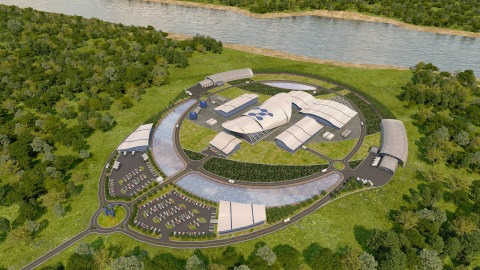Small modular reactors could redefine nuclear power. Reportedly the most important features of this solution include reliability, safety and protection of resources. America’s NuScale wants to lead Europe on a quest to build small NPPs – writes Jędrzej Stachura, editor at BiznesAlert.pl.
Small reactors as an energy supplement
Small modular reactors (SMR) are defined as reactors with a capacity of up to 300 MWe, that are mass-produced in factories and delivered to the site prefabricated. Thanks to this, economies of scale for mass production kick in, which shortens the construction time.
SMRs allow to develop small and larger energy complexes, all depending on local needs. This is mainly due to the increase in the cost of building large nuclear power units (with capacities above 1 GWe) and the need to ensure energy supply in small power grids below 4 GWe. Small reactors can be set up individually or in groups with many modules, which makes it easier to bankroll the investment. Another advantage of SMRs is that they can replace the gradually dismantled, exploited coal-fired power plants, whose capacity usually does not exceed 500 MWe.
Therefore, a small NPP can complement a large one, because it serves other purposes. If this technology becomes available in Europe, Poland and other countries in the region may benefit from it. One company is already trying to break ground, also with the participation of Poles.
NuScale, or an American Frodo on the way to SMRs
One of the biggest players in the SMR market is the American NuScale. The company has developed the technology of a modular nuclear power plant with a light-water reactor, which generates energy, heat, desalinates, produces hydrogen and introduces solutions related to process heat. NuScale says that by 2030 its first power plant with a small modular reactor (SMR) in the United States (Idaho) will be built. It is intended to have a capacity of 720 MW, to provide safe, reliable and competitively priced clean energy for the entire region. The first module will start generating energy in 2029, and the remaining ones will be ready for full operation by 2030.
Every year, the American company is growing on foreign markets. In Europe, the Americans cooperate with Bulgaria, the Czech Republic, Poland, Romania, among others. In September 2019, NuScale and the Čez group, which is also looking into SMR technology, signed an agreement to share knowledge about SMR technology. The Czech Republic operates two nuclear power plants, which meet about one third of the country’s electricity demand. The parties shall consult on the construction, operation and maintenance of the supply chain.
In February 2021, NuScale and the Bulgarian Kozloduy nuclear power plant signed an agreement on the implementation of SMR technology. The Americans have to assess to what degree this technology is suitable for the plant. Six months after that it was Poland’s trun. In September 2021, NuScale, Getka Group and Unimot signed an agreement to explore the possibility of deploying SMR technology in existing coal-fired power plants. In February 2022, NuScale and KGHM Polska Miedź signed an agreement to start work on introducing small reactors to Poland. Thanks to cooperating with the Americans on SMR technology, KGHM will meet all of its demand for electricity. NuScale reports that the first NuScale VOYGR power plant could be built in Poland as early as in 2029, which would help to reduce CO2 emissions by eight million tons per year.
Romania as the pioneer
In November 2021, the Americans signed an agreement with Romania, which they believe should be the pioneer of small nuclear power on the Old Continent. NuScale and Societatea Nationala Nuclearelectrica, a Romanian nuclear power producer, cooperate on SMRs. The first small reactors are to be operational by 2028. According to plans, the NuScale plant is expected to generate about 4 thousand jobs and help Romania to reduce CO2 emissions by four million tonnes per year. The U.S. government will allocate USD 14 million to support engineering and design work.
SMRs and the environment
The small reactors are often portrayed as the future of nuclear power. Large reactors are expensive and also produce radioactive waste that can pose a threat to the environment for hundreds of thousands of years. The nuclear industry is therefore developing smaller reactors that are to be cheaper, safer and produce less radioactive waste.
However, recent research by Stanford University has shown that SMRs may produce more waste than conventional nuclear reactors. Lindsay Krall of CISAC (the Center for International Security and Cooperation) points out that most small modular reactor (SMR) projects will increase the amount of waste that needs to be managed. This stands in stark contrast to the benefits to be derived from the introduction of the SMR technology.
High-level waste is primarily spent fuel removed from reactors once power has been produced. While low-level waste comes from the operation of reactors and medical, academic, industrial and other commercial applications of radioactive materials. Radioactive waste from spent nuclear fuel needs to be secured, which requires a technology that will effectively look after the environment. This kind of infrastructure used to store „nuclear waste” is still far and between. It’s the nuclear waste, among other things, that is the cause of the climate catastrophe, so the waste produced in SMRs should not be ignored. Therefore, countries wishing to build a reactor, small or large, must take into account that it is not only about a nuclear power plant, but also the accompanying infrastructure, that is, facilities for waste storage, and also about the production of nuclear fuel. Efficient usage of this kind of energy must be based on those pillars.









